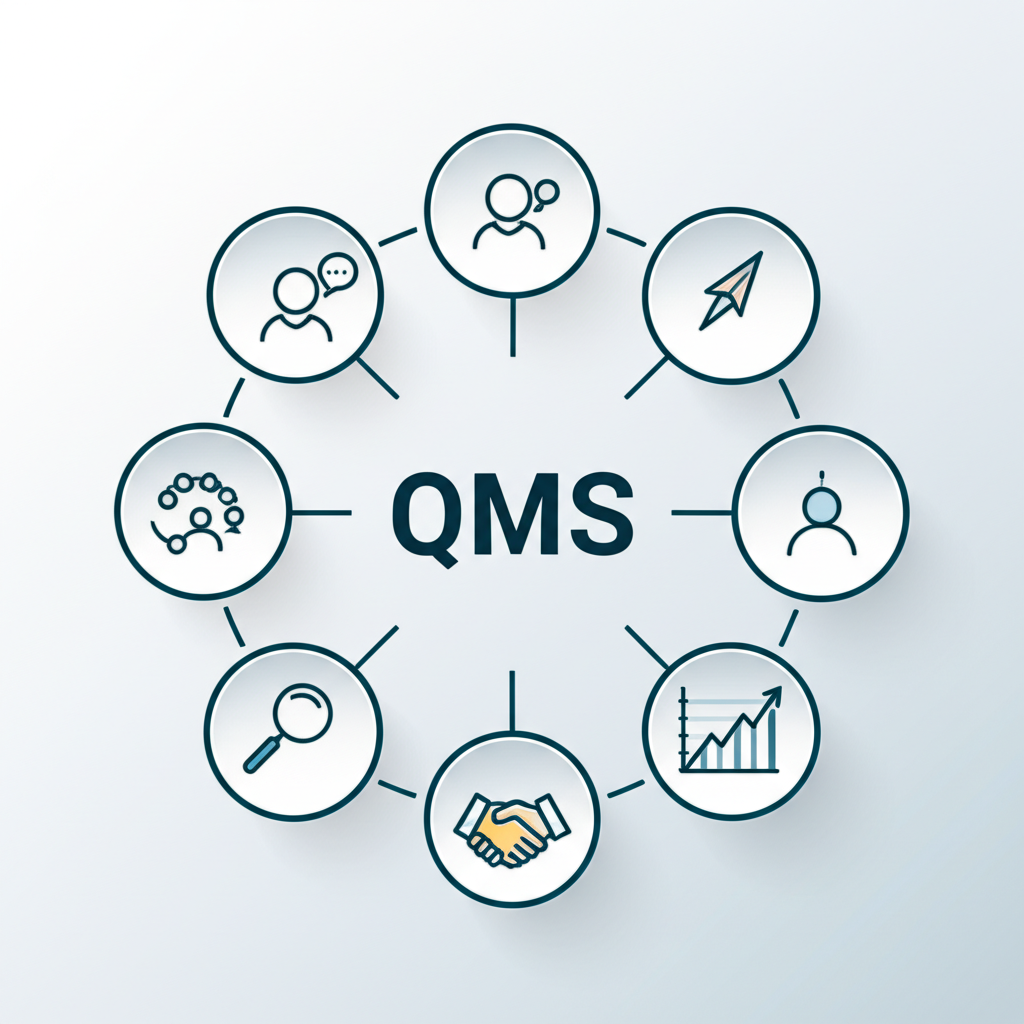ISO 9001 in Manufacturing: A Framework for Quality Success

TL;DR
ISO 9001 is the globally recognized standard for a Quality Management System (QMS). For manufacturing, it provides a strategic framework to streamline processes, ensure consistent product quality, and meet customer and regulatory requirements. Adopting ISO 9001 helps manufacturers enhance operational efficiency, build customer trust, and drive continuous improvement.
What Is ISO 9001? A Practical Definition for Manufacturers
At its core, ISO 9001 is an international standard that specifies the requirements for a quality management system (QMS). Think of it not as a rigid set of rules for a specific product, but as a blueprint for how a manufacturing organization manages its processes to consistently achieve high quality. A QMS is the collection of all the processes, policies, documented procedures, and records that direct how work is done to meet customer and regulatory requirements. It’s the engine that drives quality throughout the entire organization.
For a manufacturer, a helpful analogy is to view ISO 9001 as the master recipe for the entire factory. While individual product schematics detail what to make, the QMS details how to make it consistently, reliably, and with a focus on improvement. This framework ensures that from the moment raw materials arrive to the final product shipment, there is a controlled, repeatable, and documented process in place. This shifts the focus from simply inspecting finished goods to building quality into every step of the production cycle.
The standard is built on a process-oriented approach, encouraging organizations to identify their key processes and manage their interactions. This means understanding how activities combine to produce the desired results, thereby identifying opportunities for greater efficiency and fewer errors. It is a flexible framework applicable to any manufacturing operation, regardless of size or product complexity, designed to foster a culture of quality from the leadership team to the shop floor.

The Strategic Importance of ISO 9001 in the Manufacturing Sector
In the competitive world of manufacturing, precision, consistency, and reliability are paramount. Implementing an ISO 9001-compliant QMS is a strategic decision that delivers significant competitive advantages and tangible business benefits. It moves quality from a departmental function to a core business strategy, impacting everything from operational efficiency to market reputation. For many customers, ISO 9001 certification is a prerequisite, as it provides objective proof of a commitment to quality.
Adopting this standard helps manufacturers refine operations, boost productivity, and visibly demonstrate a dedication to quality. This commitment translates into several key benefits that directly address the challenges of the modern manufacturing environment:
- Improved Product Quality: By implementing a systematic approach to quality management, manufacturers can significantly reduce defects, rework, and waste. The focus on process control and continuous improvement ensures that quality standards are not just met but consistently elevated over time.
- Enhanced Operational Efficiency: ISO 9001 helps identify and eliminate inefficiencies within and between processes. This optimization reduces waste, saves costs, and allows the business to operate more smoothly while maintaining high output standards.
- Boosted Customer Satisfaction and Trust: Consistently delivering high-quality products that meet or exceed expectations is the most effective way to build customer loyalty. An ISO 9001 certification signals to customers that an organization is serious about quality, fostering long-term trust and credibility.
- Strengthened Supply Chain Management: The standard encourages better management of suppliers and partners. Working with suppliers who also adhere to quality standards creates a more resilient and reliable supply chain. For instance, companies requiring high-precision components often partner with ISO 9001 certified providers like XTJ, whose advanced CNC machining services guarantee parts meet exacting specifications, ensuring quality is maintained throughout the value chain.
- Facilitated Regulatory Compliance: The manufacturing industry is subject to numerous regulations. ISO 9001 provides a robust framework to help organizations meet these complex legal and statutory requirements, reducing the risk of costly penalties.
The 7 Core Principles of Quality Management
The ISO 9001 standard is built upon seven fundamental principles of quality management. These principles are not just abstract ideals; they are actionable guidelines designed to direct an organization's performance improvement efforts. For manufacturers, internalizing these principles creates a culture where quality is a shared responsibility and a constant goal.
- Customer Focus: The primary focus of quality management is to meet and exceed customer expectations. For a manufacturer, this means deeply understanding customer needs and using that knowledge to design, produce, and deliver products that provide value.
- Leadership: Strong leadership is essential for establishing a clear vision and direction for quality. Leaders must create an environment where employees are engaged and motivated to achieve the organization's quality objectives.
- Engagement of People: Competent, empowered, and engaged employees at all levels are crucial for success. In a manufacturing setting, this means valuing the expertise of shop-floor workers and involving them in process improvement initiatives.
- Process Approach: Achieving consistent and predictable results is more effective when activities are managed as interrelated processes. This principle encourages manufacturers to map out their workflows, understand the inputs and outputs of each step, and optimize the entire system.
- Improvement: Successful organizations have an ongoing focus on improvement. This involves constantly seeking opportunities to enhance processes, adapt to changing market conditions, and innovate in product development and production techniques.
- Evidence-Based Decision Making: Decisions based on the analysis and evaluation of data are more likely to produce desired results. Manufacturers should use production data, quality control metrics, and customer feedback to guide strategic and operational choices.
- Relationship Management: For sustained success, organizations must manage their relationships with interested parties, especially suppliers. Building strong, collaborative relationships with suppliers ensures a reliable flow of high-quality materials and components.
A Step-by-Step Roadmap to ISO 9001 Implementation
Developing and implementing an ISO 9001 quality management system is a structured project that requires careful planning and execution. While the journey may seem complex, breaking it down into manageable phases provides a clear path toward certification and, more importantly, a more effective organization. The following steps outline a typical roadmap for a manufacturing company.
- Establish a Quality Policy and Objectives: The first step is for leadership to define the company's commitment to quality. This quality policy should be a clear, concise document that sets the overall goals for the QMS and is communicated throughout the organization.
- Identify Key Processes and Conduct a Gap Analysis: You must identify the core processes involved in delivering your products, from design and purchasing to production and customer service. Once mapped, conduct a gap analysis to compare your existing practices against the requirements of the ISO 9001 standard to see where improvements are needed.
- Develop QMS Documentation: Based on the gap analysis, begin creating the necessary documentation. This includes procedures, work instructions, forms, and policies that describe how key processes are performed. The goal is to provide clear, consistent instructions to ensure everyone performs their tasks correctly.
- Implement the QMS and Train Employees: With the documentation in place, the next phase is implementation. This involves rolling out the new or revised processes across the organization and providing comprehensive training to all employees to ensure they understand their roles and responsibilities within the QMS.
- Conduct Internal Audits: Before seeking external certification, the organization must conduct its own internal audits. This process helps verify that the QMS is operating as intended, that processes conform to the documented procedures, and that any non-conformities are identified and addressed.
- Hold a Management Review: Leadership must formally review the performance of the QMS to assess its effectiveness and identify opportunities for improvement. This review should analyze data from internal audits, customer feedback, and process performance metrics.
- The Certification Audit: Once the QMS is fully implemented and has been internally audited, the final step is to engage an accredited certification body to conduct an external audit. If the audit is successful, the organization will be awarded its ISO 9001 certification.

Frequently Asked Questions
1. Is ISO 9001 certification mandatory for manufacturing companies?
No, ISO 9001 certification is not a legal requirement for most manufacturing sectors. However, it is often a contractual requirement from customers, particularly in industries like aerospace, automotive, and medical devices. Many companies require their suppliers to be certified to ensure the quality and reliability of their supply chain.
2. How long does it take to implement ISO 9001 and get certified?
The timeline for implementation varies significantly based on the size and complexity of the organization, as well as the resources dedicated to the project. For a small to medium-sized manufacturing company, the process can take anywhere from 6 to 18 months. This includes developing the system, implementing it, and undergoing the certification audit.
3. What is the main difference between ISO 9000 and ISO 9001?
ISO 9000 is a family of quality management standards, and ISO 9001 is one of the standards within that family. ISO 9000 provides the fundamental concepts and vocabulary, while ISO 9001 specifies the requirements for a quality management system. In short, ISO 9001 is the only standard in the series to which an organization can be certified.
-
Posted in
ISO 9001, manufacturing, QMS, quality assurance, quality management





